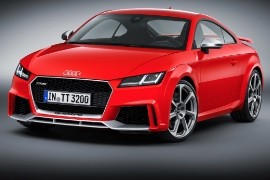AUDI TT RS Coupe Models/Series Timeline, Specifications & Photos
First production year: 2009
Engines: Gasoline
Body style: Coupé (two-door)
The top of the range version of the third-generation Audi TT was facelifted in 2019, most of the improvement revolving around the design of the model, with most of the technical bits being left alone.
Both the front and the rear ends have been redesigned, albeit in the subtle Audi way of changing things without starting from a clean sheet. At the front, the quattro logo now has a matt titanium-look and sits in the lower section of the grille, which is gloss black and surrounded by the hallmark matt black Singleframe.
The side intakes found on its predecessor have been enlarged and are each divided by vertical strips that make car appear even wider. The front spoiler blade has the same color as the rest of the body but can be optionally painted in a matt aluminum look, glass black or even carbon.
The standard LED headlights have been revised as well, while the optional matrix LED lights are even more responsive. The rear gets optional matrix OLED taillights, which have a distinctive 3d design and can put on a spectacular show every time the car is turned on.
Most of the interior has been left alone, although Audi did specify the car with an improved RS package as an option. Among various exterior enhancements, the package adds red or blue highlights to the air vents, seat belts and the floor mats, while an extended version of the package also comes with contrasting design elements on the seats and center console.
The little TT from the Audi started its career in 1998 with a 180 hp engine. In 2017 the TT RS Coupe had twice that.
Audi has a long history with the 5-cylinder engines, which were installed on the first Audi Coupe in the late '70s. And they installed it also in their little Coupe TT RS with very good results on the clock.
The TTRS could be spotted due to its larger intakes on the front bumper, with a lower silver lip. The rear-view mirror cases were painted in silver as well. From the side, the TTRS was equipped with bespoke 20” light-alloy wheels to flush to the bodywork. A big wing was installed on the trunk lid and, to complete the sport's image, the TTRS featured two big oval exhaust pipes left and right of a big diffuser.
Inside the cabin, the Audi R8 steering-wheel captured the attention with its red starting button on it. The Audi Virtual Cockpit was standard for the TTRS. The bucket seats were nicely crafted in leather and Alcantara.
But the main reason why the TTRS was sought after was its performances. With a 400 hp engine transferred to the all four wheels via a 7-speed dual-clutch S-Tronic gearbox, the TTRS was a baby supercar, a threat to the Audi R8 which, in some versions was only 0.1 seconds faster on 0 to 100 kph (0-62 mph) than the top of the range TT.
The second generation of the Audi TT received numerous upgrades and versions for those who asked for more performance.
In 2009, Audi introduced the second generation of the Audi TT. It was a revolution over its predecessor, with an enhanced and improved drivetrain and aerodynamic. The first generation had some trouble making these two right and suffered from the aerodynamic lift at high speeds. But not anymore. Moreover, Audi dared to offer the car in high-performance spec version, such as the TT RS Plus.
For starters, it modified the exterior. A gray lip-spoiler at the front and black door-mirrors were installed to differentiate from the rest of the non-Plus versions. In the back, a fixed-wing helped the car get more traction on the rear axle at high speeds. A specific set of 19" light-alloy wheels was installed.
Inside, the front passengers' sport-bucket seats featured high bolstering on the outer sides to keep the occupants in place during hard cornering. They were inspired by racing seats and featured two cut-outs on the upper side for a racing harness. But those harnesses were missing. For the driver, Audi installed an instrument cluster with two large dials for the speedometer and tachometer.
Under the hood, the TT RS Plus featured a 2.5-liter engine pumped out up to 360 hp mated to either a 6-speed manual or a 7-speed automatic (DSG – dual-clutch). The magnetic ride controlled suspension was fitted as an option.
In 2009, Audi introduced the TT range's high-performance version, named RS, which was offered as a roadster or as a coupe.
Audi turned its attention back to the five-cylinder engine configuration that made it famous on the rally stages from the beginning of the '80s. Its motorsport heritage convinced the German engineers to take a second look and build a powerful version of the nimble TT.
On the outside, the TT RS featured a different front bumper with a honeycomb pattern, unlike the TTS version, which featured horizontal and vertical slats on the grille and on the apron's the side scoops. Its silver door-mirror caps sported additional turn-signals, like the S-version. In the back, Audi installed a fixed-wing on the trunk lid. It wasn't there only for design purposes, and it created actual downforce.
The interior was finished with fine leather sport seats and a flat-bottom steering wheel and featured the RS badge on it. Additional badges and logos appeared on the seats, in the tachometer and on the door sill trims. The driver's information system specific to the RS and featured a turbo boost pressure gauge, oil temperature, and a lap timer.
The RS ran on a 2.5-liter turbocharged engine that produced 335 bhp. The engine was mated to either a 6-speed manual or seven-speed S-tronic automatic (twin-clutch) gearbox, and the power was sent in all corners. The TT RS featured an adaptive suspension that allowed higher cornering speeds.



